【最新】北京课改版七年级英语上册School things第一课时教案
- 格式:doc
- 大小:98.50 KB
- 文档页数:3
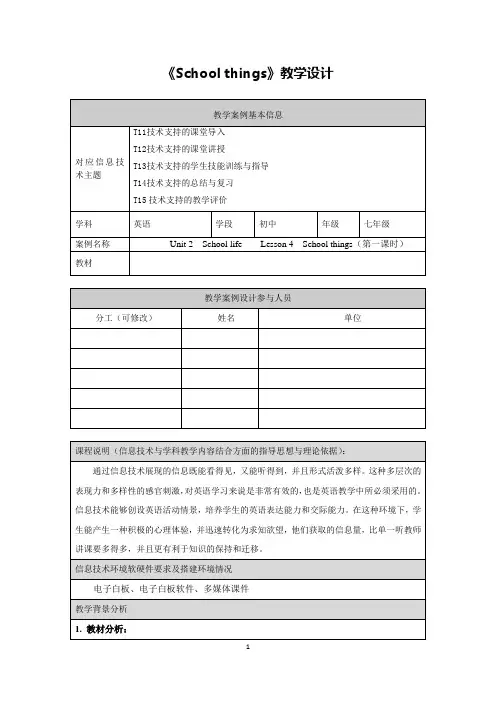
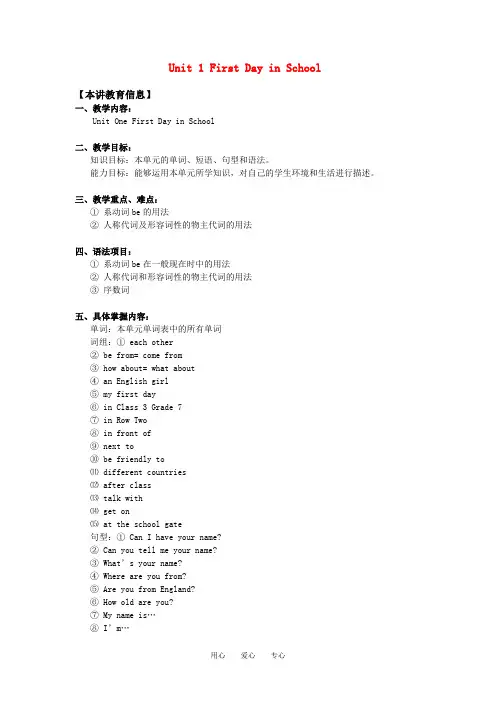
Unit 1 First Day in School【本讲教育信息】一、教学内容:Unit One First Day in School二、教学目标:知识目标:本单元的单词、短语、句型和语法。
能力目标:能够运用本单元所学知识,对自己的学生环境和生活进行描述。
三、教学重点、难点:①系动词be的用法②人称代词及形容词性的物主代词的用法四、语法项目:①系动词be在一般现在时中的用法②人称代词和形容词性的物主代词的用法③序数词五、具体掌握内容:单词:本单元单词表中的所有单词词组:① each other② be from= come from③ how about= what about④ an English girl⑤ my first day⑥ in Class 3 Grade 7⑦ in Row Two⑧ in front of⑨ next to⑩ be friendly to⑾ different countries⑿ after class⒀ talk with⒁ get on⒂ at the school gate句型:① Can I have your name?② Can you tell me your name?③What’s your name?④ Where are you from?⑤ Are you from England?⑥ How old are you?⑦My name is…⑧I’m…⑨I’m from Beijing, China.⑩I’m twelve years old.⑾ This is my first day in this school.⑿ A girl is in front of me.⒀ The boy next to me is Yang Lin.⒁ My classmates are from different countries.⒂ How about you?六、重点知识讲解与拓展:① in front of 在……前面例如:I am in front of Zhang Fang.The school is in front of the park.易混词:in the front of 在……前部The teacher is in the front of the classroom.The teacher’s desk is in the front of the classroom.反义词:behind 在……后面Zhang Fang is behind me.The big tree is behind our classroom.② how about ……怎么样?同义词what about…?I am a student, I am from Canada, how about you?Wang Lin is from China, Liu Tao is from Korea.What about Zhang Jun?③ be from 来自于……同义词 come from④ different 不同的反义词 same 相同的be different from 与……不同China is different from America.I am different from the boys over there.English is different from Chinese.语法项目:1. 数词:①基数词变序数词的规则②序数词的用法序数词是用来表示顺序的,例如the first day the second classmy first teacherhis second bike2. 人称代词英语中的人称代词为第一人称,第二人称和第三人称,在句中作主语的代词用主格形式,作宾语的代词用宾格形式,表示所属关系时用代词的所有格形式,例如:第一人称:I am a middle school student.Let me help you.This is my book.第二人称:How are you?Is this your pen?May I ask you a question?第三人称:Who is he?His name is Jack.Her book is on the desk.Their school is very big.人称代词一览表:。
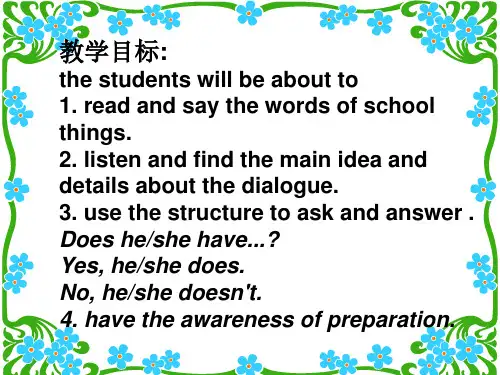
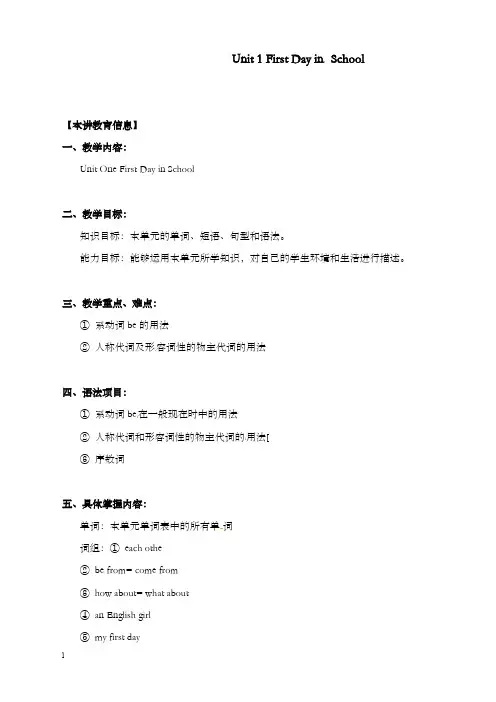
Unit 1 First Day in School【本讲教育信息】一、教学内容:Unit One First Day in School二、教学目标:知识目标:本单元的单词、短语、句型和语法。
能力目标:能够运用本单元所学知识,对自己的学生环境和生活进行描述。
三、教学重点、难点:①系动词be的用法②人称代词及形容词性的物主代词的用法四、语法项目:①系动词be在一般现在时中的用法②人称代词和形容词性的物主代词的用法[③序数词五、具体掌握内容:单词:本单元单词表中的所有单词词组:①each othe②be from= come from③how about= what about④an English girl⑤my first day⑥in Class 3 Grade 7⑦in Row Two⑧in front of[⑨next to⑩be friendly to⑾different countries⑿after class⒀talk with[K]⒁get on⒂at the school gate句型:①Can I have your name?②Can you tell me your name?③What’s your name?④Where are you from?⑤Are you from England?⑥How old are you?⑦My name is…⑧I’m…⑨I’m from Beijing, China.⑩I’m twelve years old.⑾This is my first day in this school.⑿A girl is in front of me⒀The boy next to me is Yang Lin.⒁My classmates are from different countries.⒂How about you?六、重点知识讲解与拓展:①in front of 在……前面例如:I am in front of Zhang Fang.The school is in front of the park.易混词:in the front of 在……前部The teacher is in the front of the classroom.The teacher’s desk is in the front of the classroom. 反义词:behind 在……后面Zhang Fang is behind me.The big tree is behind our classroom.②how about ……怎么样?同义词what about…?I am a student, I am from Canada, how about you? Wang Lin is from China, Liu Tao is from Korea. What about Zhang Jun?③be from 来自于……同义词come from④different 不同的网]反义词same 相同的be different from 与……不同China is different from America.I am different from the boys over there.English is different from Chinese语法项目:1. 数词:①基数词变序数词的规则②序数词的用法序数词是用来表示顺序的,例如the first day the second classmy first teacherhis second bike2. 人称代词英语中的人称代词为第一人称,第二人称和第三人称,在句中作主语的代词用主格形式,作宾语的代词用宾格形式,表示所属关系时用代词的所有格形式,例如:第一人称:I am a middle school student.Let me help you.This is my book.第二人称:How are you?Is this your pen?May I ask you a question? 第三人称Who is he?His name is Jack.Her book is on the desk. Their school is very big. 人称代词一览表:。
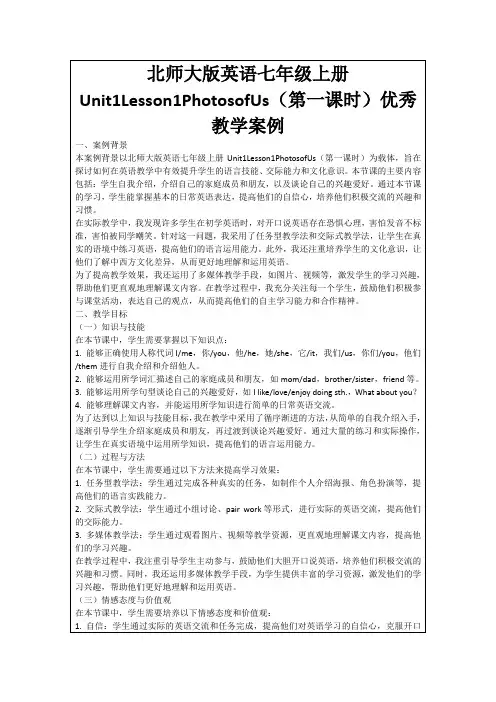
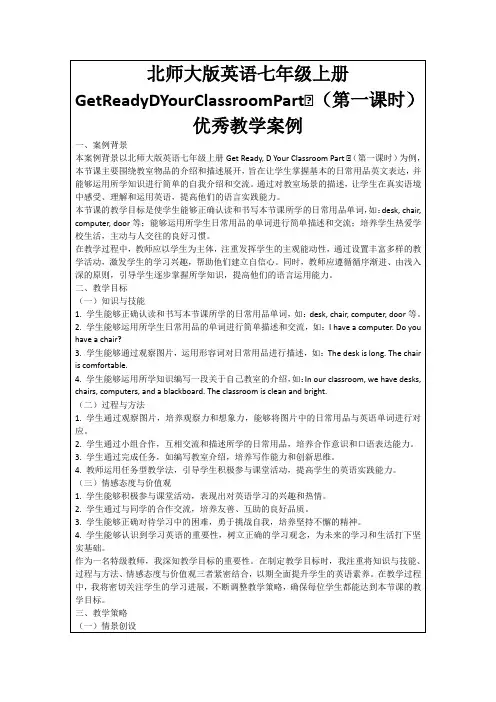
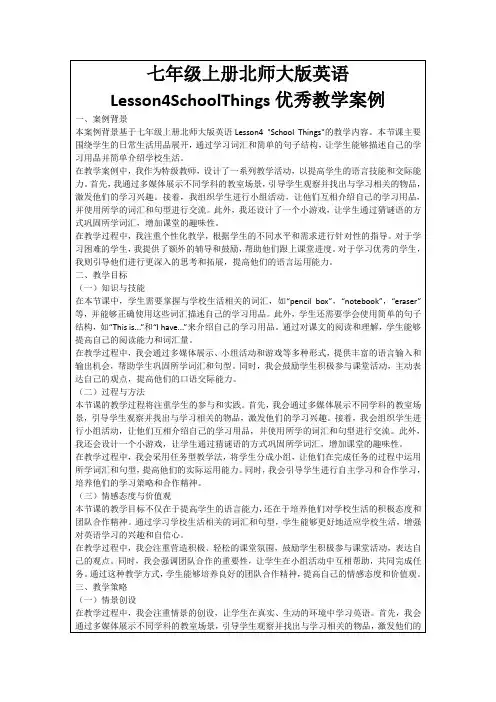
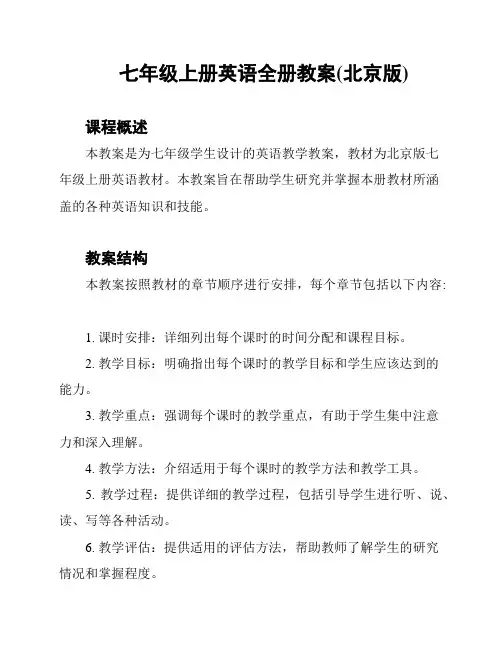
七年级上册英语全册教案(北京版)课程概述本教案是为七年级学生设计的英语教学教案,教材为北京版七年级上册英语教材。
本教案旨在帮助学生研究并掌握本册教材所涵盖的各种英语知识和技能。
教案结构本教案按照教材的章节顺序进行安排,每个章节包括以下内容:1. 课时安排:详细列出每个课时的时间分配和课程目标。
2. 教学目标:明确指出每个课时的教学目标和学生应该达到的能力。
3. 教学重点:强调每个课时的教学重点,有助于学生集中注意力和深入理解。
4. 教学方法:介绍适用于每个课时的教学方法和教学工具。
5. 教学过程:提供详细的教学过程,包括引导学生进行听、说、读、写等各种活动。
6. 教学评估:提供适用的评估方法,帮助教师了解学生的研究情况和掌握程度。
7. 家庭作业:指导学生在课堂外进行相关练和作业。
教案特色本教案注重培养学生的英语综合运用能力,采用了多种教学方法和活动形式。
教案中融入了大量的听说训练,并结合实际情境进行综合运用。
同时,也注重学生的合作研究和自主研究能力的培养,鼓励学生通过小组活动和探究式研究来提高英语能力。
教材章节概览- Unit 1: Greetings and Introductions- Unit 2: My Family- Unit 3: My School- Unit 4: My Hobbies- Unit 5: Daily Routines- Unit 6: Food and Drinks- Unit 7: Holidays and Festivals结语本教案为教师提供了一个系统、详细的教学指南,帮助教师有条理地进行课堂教学。
同时,通过多样化的教学方法和活动形式,可以提高学生的研究兴趣和研究效果。
希望学生们在这些教案的指导下,能够积极参与英语研究,并取得良好的研究成果。
请注意,本教案仅为参考,实际教学中应根据实际情况进行调整和补充。
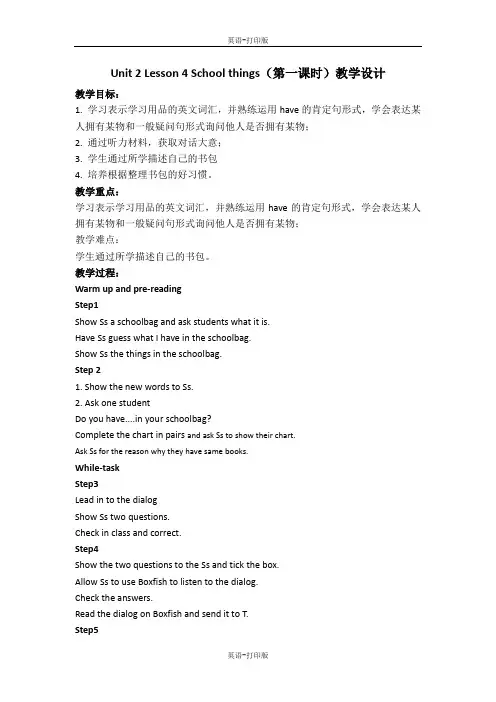
Unit 2 Lesson 4 School things(第一课时)教学设计教学目标:1. 学习表示学习用品的英文词汇,并熟练运用have的肯定句形式,学会表达某人拥有某物和一般疑问句形式询问他人是否拥有某物;2. 通过听力材料,获取对话大意;3. 学生通过所学描述自己的书包4. 培养根据整理书包的好习惯。
教学重点:学习表示学习用品的英文词汇,并熟练运用have的肯定句形式,学会表达某人拥有某物和一般疑问句形式询问他人是否拥有某物;教学难点:学生通过所学描述自己的书包。
教学过程:Warm up and pre-readingStep1Show Ss a schoolbag and ask students what it is.Have Ss guess what I have in the schoolbag.Show Ss the things in the schoolbag.Step 21. Show the new words to Ss.2. Ask one studentDo you have....in your schoolbag?Complete the chart in pairs and ask Ss to show their chart.Ask Ss for the reason why they have same books.While-taskStep3Lead in to the dialogShow Ss two questions.Check in class and correct.Step4Show the two questions to the Ss and tick the box.Allow Ss to use Boxfish to listen to the dialog.Check the answers.Read the dialog on Boxfish and send it to T.Step5Ask Ss to finish the Cloze.Ask them to discuss in groups. And show their work. Read the passage together. Post -taskSpeaking:Use the given structure and talk about your schoolbag.Home workReview what you have learned today.Write a short passage about your schoolbag.。
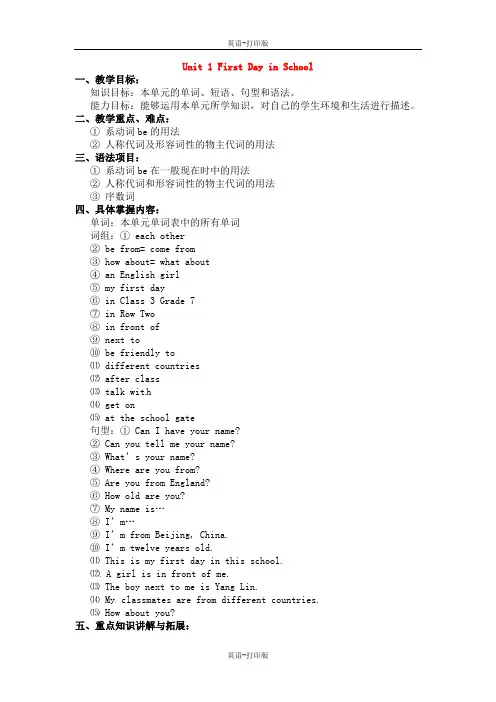
Unit 1 First Day in School一、教学目标:知识目标:本单元的单词、短语、句型和语法。
能力目标:能够运用本单元所学知识,对自己的学生环境和生活进行描述。
二、教学重点、难点:①系动词be的用法②人称代词及形容词性的物主代词的用法三、语法项目:①系动词be在一般现在时中的用法②人称代词和形容词性的物主代词的用法③序数词四、具体掌握内容:单词:本单元单词表中的所有单词词组:① each other② be from= come from③ how about= what about④ an English girl⑤ my first day⑥ in Class 3 Grade 7⑦ in Row Two⑧ in front of⑨ next to⑩ be friendly to⑾ different countries⑿ after class⒀ talk with⒁ get on⒂ at the school gate句型:① Can I have your name?② Can you tell me your name?③What’s your name?④ Where are you from?⑤ Are you from England?⑥ How old are you?⑦My name is…⑧I’m…⑨I’m from Beijing, China.⑩I’m twelve years old.⑾ This is my first day in this school.⑿ A girl is in front of me.⒀ The boy next to me is Yang Lin.⒁ My classmates are from different countries.⒂ How about you?五、重点知识讲解与拓展:① in front of 在……前面例如:I am in front of Zhang Fang.The school is in front of the park.易混词:in the front of 在……前部The teacher is in the front of the classroom.The tea cher’s desk is in the front of the classroom.反义词:behind 在……后面Zhang Fang is behind me.The big tree is behind our classroom.② how about ……怎么样?同义词what about…?I am a student, I am from Canada, how about you? Wang Lin is from China, Liu Tao is from Korea.What about Zhang Jun?③ be from 来自于……同义词 come from④ different 不同的反义词 same 相同的be different from 与……不同China is different from America.I am different from the boys over there.English is different from Chinese.语法项目:1. 数词:①基数词变序数词的规则②序数词的用法序数词是用来表示顺序的,例如the first day the second classmy first teacherhis second bike2. 人称代词英语中的人称代词为第一人称,第二人称和第三人称,在句中作主语的代词用主格形式,作宾语的代词用宾格形式,表示所属关系时用代词的所有格形式,例如:第一人称:I am a middle school student.Let me help you.This is my book.第二人称:How are you?Is this your pen?May I as k you a question?第三人称:Who is he?His name is Jack.Her book is on the desk.Their school is very big.人称代词一览表:。
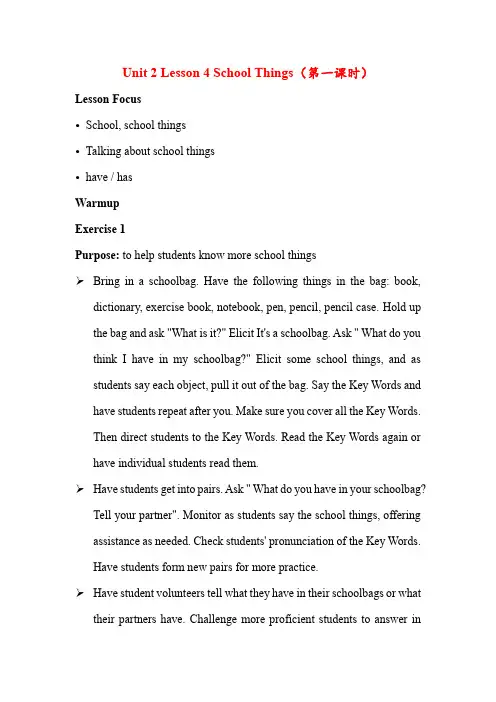
Unit 2 Lesson 4 School Things(第一课时)Lesson Focus•School, school things•Talking about school things•have / hasWarmupExercise 1Purpose: to help students know more school things➢Bring in a schoolbag. Have the following things in the bag: book, dictionary, exercise book, notebook, pen, pencil, pencil case. Hold up the bag and ask "What is it?" Elicit It's a schoolbag. Ask " What do you think I have in my schoolbag?" Elicit some school things, and as students say each object, pull it out of the bag. Say the Key Words and have students repeat after you. Make sure you cover all the Key Words.Then direct students to the Key Words. Read the Key Words again or have individual students read them.➢Have students get into pairs. Ask " What do you have in your schoolbag?Tell your partner". Monitor as students say the school things, offering assistance as needed. Check students' pronunciation of the Key Words.Have students form new pairs for more practice.➢Have student volunteers tell what they have in their schoolbags or what their partners have. Challenge more proficient students to answer inplete sentences using I have. .. or He / She has. ... Make sure students use articles correctly.➢Direct students to School things in the Picture Dictionary on page 104 for them to use as a reference.➢If time allows, do Workbook page 81, Exercise 1. Alternately, assign for homework.ReadingExercise 2Purpose: to help students understand the content of the text and to pay attention to words that are used to describe school things➢Direct students to the dialogue. Say " Read the dialogue. What classes does Jaming have today?" Monitor as students read the dialogue. When they've finished, ask " What classes does Jiaming have?" Elicit maths, art, PE, science, Chinese, history. If you feel your students are ready to do the exercise, you may skip this step.➢Direct students to the list to the right of the dialogue. Read the list aloud or have a student read it. If necessary, have the objects in the list in class and point to them as they are read aloud or have students point to them. Then say " Now read the dialogue again. What should Jiaming have in his schoolbag today? Tick the correct things". Monitor as students are reading and ticking the things, offering assistance as needed. If students need support, you may have them work in pairs.➢Go over the answers, having individual students say the answers aloud. AnswersChinese book, history book, maths exercise book, notebooks, pencil case, science bookExercise 3Purpose: to help students understand the text and practise the language orally➢Direct students to Exercise 2. Say " Listen to the dialogue". Play the recording, the first time having students just listen. Then say "Listen and read along". Play the recording again, encouraging students to read along. Play the recording as many times as necessary, having students read along.➢Challenge students to read without the recording. Have individual students volunteer to read parts or all of the text aloud to the class. SpeakingExercise 4Purpose: to help students talk about school things in a student's schoolbag ➢Ask again " What classes does Jiaming have today? Elicit maths, art, PE, science, Chinese, history. Then ask "What does he have in his schoolbag in the end? What isn't in his bag? Talk with a partner". Have two students model the Example dialogue by reading it aloud. If you feel your students are ready to do the exercise, you may skip this step.➢Have students get into pairs. Monitor as your students list the school things in Jiaming's schoolbag, offering assistance as needed. Check students' pronunciation of the Key Words. Make a list of any serious mistakes and have an anonymous feedback session at the end of the activity.Expansion: What about You?Note: Use this activity to give students more practice. Have students get into pairs. Ask students to identify what they have in their bags today. Ask more proficient students to tell what they need for tomorrow. Continue with all the days of the school week.VocabularyExercise 5Purpose: to help students identify different books used at school➢Hold up the Student Book. Ask "What is it?" Elicit It's a book. Then ask " What kind of book is it?" If students have trouble answering, ask "Is it a maths book?" Elicit No. Then elicit or provide It's an English book. If you feel your students are ready to do the exercise, you may skip this step.➢Direct students to the words in the box. Read the words aloud or have students read them. Then say "Look at the different kinds of books you use at school. Write the correct number after the words". Monitor as students write the numbers, offering assistance as needed. If studentsneed support, have them work in pairs.➢Go over the answers, having individual students say the answers aloud. Answers1. English book;2. notebook;3. exercise book;4. dictionary;5. maths book;6. science bookExpansion: Play a Game!Note: Use this activity to give students more practice. Have students identify all the different books in the classroom. Have students form three or four teams and stand in lines. Say a book, for example, "Dictionary!" Have the first person in each line run and touch the book. Students should run over to the dictionary. The first student to touch the correct book wins. Those students should then go to the back of the line, and the next student in each line tries to find the book that you call out. Continue playing the game until all students have had a turn.。
《School things》教学设计
一、教学目标
1.学生能够听懂、会说、认读单词:pencil,pen,ruler,eraser,book。
2.学生能够运用句型“What's this?It's a...”询问和回答学习用品的名称。
3.培养学生爱护学习用品的习惯。
二、教学重难点
1.重点:掌握学习用品的单词和句型。
2.难点:准确发音和运用句型。
三、教学方法
直观教学法、游戏教学法、情景教学法。
四、教学过程
1.导入
(1)展示一个书包,让学生猜猜里面有什么学习用品,引出本节课的主题。
(2)教师从书包里拿出学习用品,问学生“What's this?”引出句型。
2.新授
(1)学习单词。
1.展示学习用品的图片和单词卡片,教学生认读。
2.玩“找朋友”游戏,巩固单词记忆。
(2)学习句型。
3.教师拿着学习用品,问“What's this?”引导学生回答“It's a...”
4.学生两人一组,用句型互相询问和回答学习用品的名称。
3.练习
(1)完成课本上的练习,连线或填空,巩固单词和句型。
(2)小组活动,用句型描述小组内成员的学习用品。
4.巩固拓展
(1)玩“学习用品拍卖会”游戏,学生用英语进行竞拍。
(2)让学生讨论如何爱护学习用品。
5.课堂总结
(1)让学生总结本节课所学的单词和句型。
(2)教师强调爱护学习用品的重要性。
教学基本信息课题Lesson 4 School Things课型新授课年级七年级上册教学目标在本课学习结束时,学生能够:1.熟练掌握本课词汇2.能够熟练地运用英语谈论学校生活。
3.熟练掌握have,has的用法4. Pronunciation [i:]教学重难点重点:have,has的用法难点:能够熟练地运用本课的知识进行交流,谈论学校生活.教学过程过程教学活动设计意图Step 1 Warm-up 1.Greeting2.Free talk(出示一个书包)What’s this?Do you have a schoolbag?What do you have in your schoolbag? 由对话形式引出课题。
Step 2Presentation出示图片,直观教授新单词Quick mind 扩大词汇量巩固单词Step 3 Listening 培养学生英语的运用能力,同时引出时间介词in,on at的用法Step 4 reading What’s the dialogue mainly about?A.School things in Jiaming’s schoolbagB.Books in Jiaming’s schoolbag.C.School classes in Jiaming’s school.Read the dialogue and answer the questions.1.Is Jiaming’s bag heavy?Yes, it is./Yes.2. Does he have his history book in his schoolbag?No, he doesn’t./No.3. What can he take out?He can take out his English dictionary.分角色表演对话熟练掌握时间介词的用法Step 5 Speaking 3-4人一组,用have /has 来询问书包里的东西,以及今天的课程情况。
[标签:标题]篇一:北京仁爱版七年级英语上册全部教学案腰店一初中师生共用教学案年级:七年级科目:英语课题:Unit 1-Topic 1 SectionA 课时Period 1 执笔:刘京审核:七年级英语组课型:新授学习目标:1、从Aa-Gg的书写2、交际英语A. Maria,hi.B. Kangkang,hi.C. Good morning .D. Hi,Michael.()5、——Thanks.A. Nice to meet you.合作交流:1、Good morming.早上好。
此句为正式问候语,用于早晨至中午12点以前。
它的答语仍然用Good morming.2、Hi!喂!你好!Hello!也是“喂!你好!”的意思。
hi和hello英语中使用频率最高的日常用语之一,多用于同学、同时、熟人以及朋友之间相互打招呼,语气比较随便,意为“你好”。
3、—Are you Michael?你是迈克尔吗?—Yes,I am.是的,我是。
Are you···?是一般疑问句,意思是“你是······吗”,可以用来询问姓名、职业、身份、年龄等问题,回答肯定的用Yes,否定的用No。
4、—Welcome to China!欢迎到中国来!—Thank you!谢谢。
welcome to+地点名词欢迎到······来。
习题巩固:Ⅰ、按照四线格要求写出Aa-Gg。
()1、—you Li Ping?—Yes,I .A.Are;amB.I;amC. Are;areD.Is;am ()2、——Nice to meet you,too. A.Fine,thank you.B. Thank youC. Yes,I am.D. Nice to meet you.()3、—Are you Li Weikang?—A. Yes,I’m.B. No,I’m.C. Yes,I am.D. No,I am.()4、—Hi,Jane—B. Good morning.C. Yes,I am.D. Welcome to Beijing Ren’ai International(国际的)School! Ⅲ、从Ⅱ栏选出对应的答语。
授课日期课型Reading and speaking 授课教师
教学课题School things 总课时:2 第 1 课时
教学目标在本课学习结束时,学生能够:
1.听说读有关学校用品的词汇;
2.通过阅读获取对话大意和佳明今天书包里应该有什么及今天有什么课的具体信息;
3.初步体验和感知have的表意功能和用法;
4.使用获取的信息,运用Does Jiaming have …? Yes, he does./ No, he doesn’t口头谈论
佳明今天书包里应该有什么。
教学重点学校用品的词汇阅读获取对话大意和佳明今天书包里应该有什么及今天有什么课的具体信息
教学难点如何引领学生获取对话大意和佳明今天书包里应该有什么教学方法引领归纳法
教学准备Ppt students’ sheet
教学过程
教师活动设计学生活动设计设计意图
时间
安排Pre-reading
Step1
Show some pictures about school,
then ask “What can you see?”to
lead Ss to say key words.
Play the recording for Ss to listen
and repeat
Step2
Ask “ What things do you use every
day at school? to lead Ss to say: I
use…every day .
Step3
Ask “What do you have in your
schoolbag?” to elicit more sc hool
things.
Then play the recording for the
students to listen and repeat.
While-reading
Step4
Tell Ss that Jiaming and his dad are
talking. What are they talking
about? Please read their dialogue
and find out main idea.
Look at the pictures and
say key words.
listen and repeat
say: I use…every day .
Say school things in
their schoolbag
listen and repeat
read their dialogue and
find out main idea.
用图片激活学生已知
词汇并学习新词汇
熟悉词汇读音和熟悉
词汇
引领学生谈论在学校
每天用的物品,进一
步熟悉词汇
用问题激活学生已知
词汇并学习新词汇
熟悉词汇读音和词汇
培养学生阅读找大意
的能力
6’
2’
6’
4’
3’
Step5
Ask Ss to read the dialogue again and tick school things Daming should have in his bag. Then check in pairs, then in class.
Step6
Play the recording for Ss to listen and repeat.
Post-reading
Step7
Have Ss work in pairs to ask and answer using :
Does Jiaming have …?
Yes, he does. / No, he doesn’t.
Step8
Have Ss work in pairs to ask and answer using :
Do you hav e …?
Yes, I do. / No, I don’t.
Step9 homework
1. 跟读录音
2.完成学案上的题read the dialogue again
and tick school things
Daming should have in his
bag. Then check in pairs,
then in class.
listen and repeat.
work in pairs to ask and
answer using :
Does Jiaming have …?
Yes, he does. / No, he
doesn’t.
work in pairs to ask and
answer using :
Do you have …?
Yes, I do. / No, I don’t.
Finish the homework
培养学生阅读找具体
细节信息能力
跟读,培养语音语调
熟悉语言
培养口头表达能力,
进一步熟悉对话和初
步体验和感知have
的表意功能和用法
在较真实的环境中体
验和感知have的表
意功能和用法
巩固课上所学
6’
3’
7’
7’
1’
板
书
设
计
课
后
反
思
巧设问题引领学生学习,学生很喜欢。
目标基本达成。